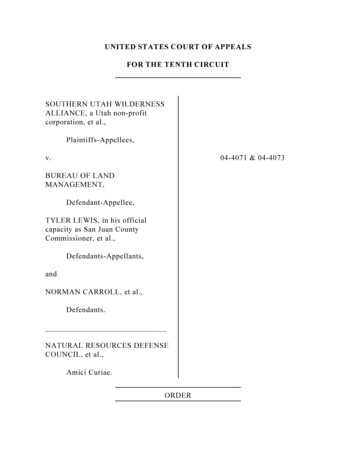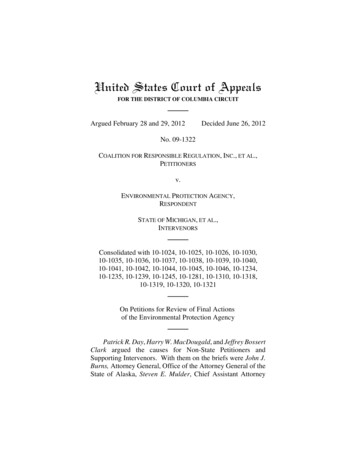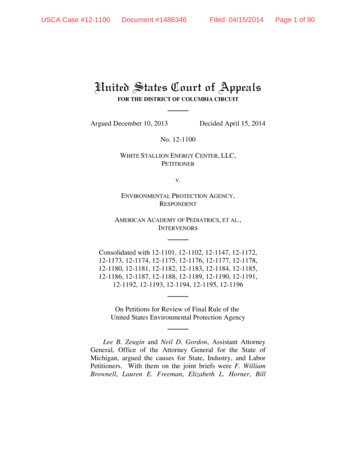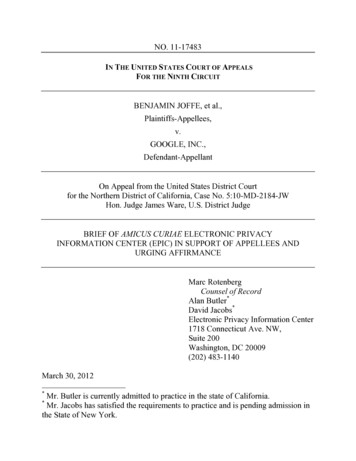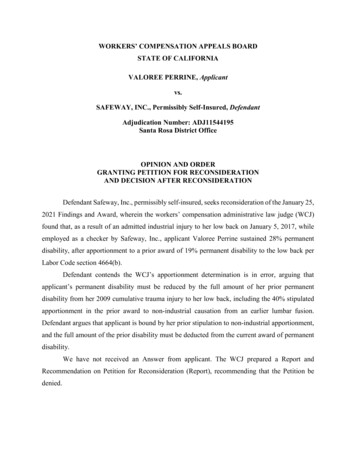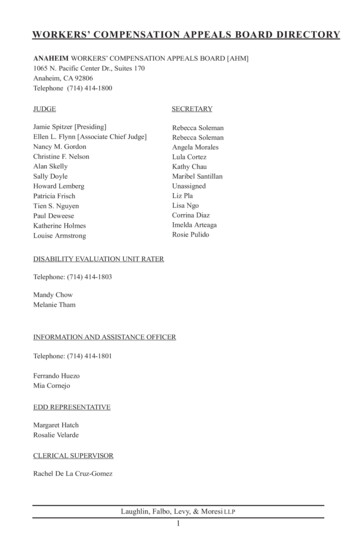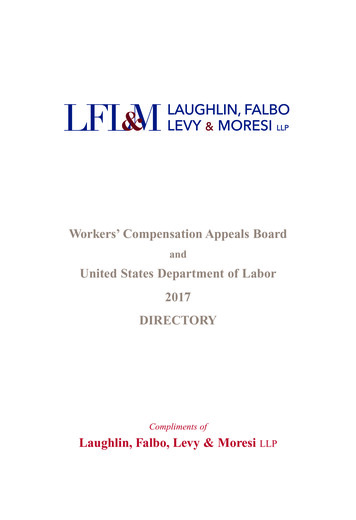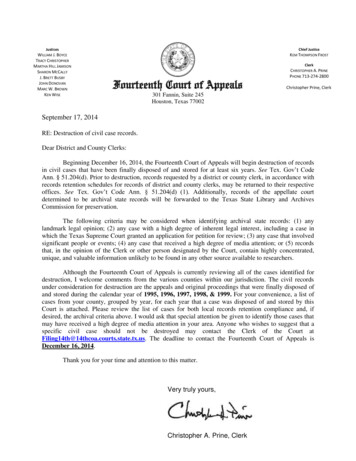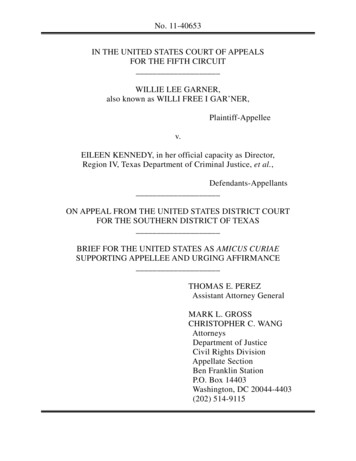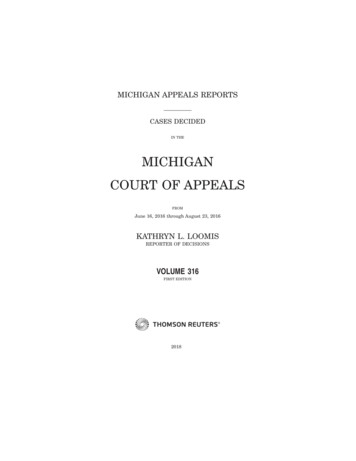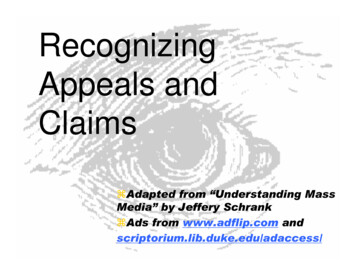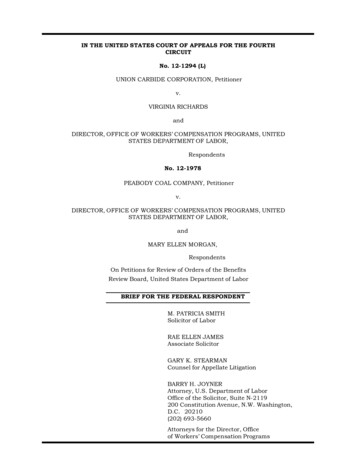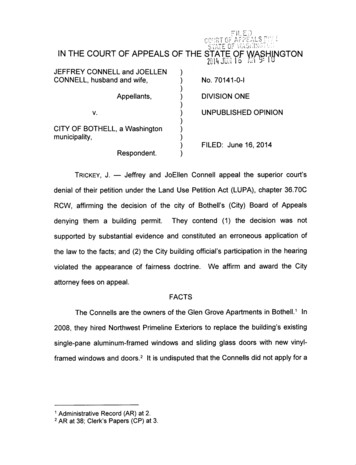
Transcription
'" !!C iJ;;RT OF'APPEALS.STATE Or WASulNblv.IN THE COURT OF APPEALS OF THE STATE Of WASHINGTONJEFFREY CONNELL and JOELLENCONNELL, husband and wife,No. 70141-0-1Appellants,DIVISION ONEUNPUBLISHED OPINIONCITY OF BOTHELL, a Washingtonmunicipality,FILED: June 16, 2014Respondent.Trickey, J. — Jeffrey and JoEllen Connell appeal the superior court'sdenial of their petition under the Land Use Petition Act (LUPA), chapter 36.70CRCW, affirming the decision of the city of Bothell's (City) Board of Appealsdenying them a building permit.They contend (1) the decision was notsupported by substantial evidence and constituted an erroneous application ofthe law to the facts; and (2) the City building official's participation in the hearingviolated the appearance of fairness doctrine.We affirm and award the Cityattorney fees on appeal.FACTSThe Connells are the owners of the Glen Grove Apartments in Bothell.1 In2008, they hired Northwest Primeline Exteriors to replace the building's existingsingle-pane aluminum-framed windows and sliding glass doors with new vinylframed windows and doors.2 It is undisputed that the Connells did not apply for a1 Administrative Record (AR) at 2.2 AR at 38; Clerk's Papers (CP) at 3.
No. 70141-0-1/2building permit for the work and that a permit was required by Bothell MunicipalCode (BMC) 20.02.095.3After receiving a complaint regarding mold and water damage at theapartments, the City investigated and discovered the work had been performedwithout a permit.4 The Connells submitted an application for an after-the-factpermit. The City reviewed the application, concluded that the installation n of inconsistency."5coderequirements,andissuedaThough the Connells appealed the City'sdecision to the City's Board of Appeals, they ultimately abandoned the appealand the permit application lapsed.6In 2011, the Connells submitted a second permit application.7TheConnells sought an exemption under BMC 20.02.090(K) and (L), which providethat the City may approve a permit for work that does not conform to code ifstrictcompliance is impractical or the installation method is equivalent to thatprescribed in the code.8 Along with the application the Connells provided a copy3Though the Connells' LUPA petition challenged the City's determination that a buildingpermit was required, the superior court dismissed this claim of error in a separate order,which the Connells did not appeal. CP at 98-99.4 AR5 AR6AR7 ARatatatat2.11.11-12.53.8 BMC 20.02.090(K) states, in relevant part:Wherever there are practical difficulties involved in carrying out theprovisions of this code, the building official shall have the authority togrant modifications for individual cases, upon application of the owner orowner's representative; provided, the building official shall first find thatspecial individual reason makes the strict letter of this code impractical
No. 70141-0-1/3of the manufacturer's installation instructions as well as results of water leakagetesting performed on four of the new windows. The results showed that one ofthe four windows failed the testing because water leaked through the area wherethe interlock and sill met.9Michael DeLack, the City's building official, denied the application.10 Henoted that[t]he existing window and door assemblies were removed and thenew assemblies were altered (nailing flanges removed) and set intothe exiting [sic] framed openings without flashing. The applicant isclaiming this to be a typical "finless" or "collapse" type ofinstallation.However the non-permitted installations are relyingsolely on sealant (caulk) placed between the framed opening andthe window and door assemblies to prevent moisture intrusion intothe building. 11*and the modification is in compliance with the intent and purpose of thiscode and that such modification does not lessen health, accessibility, lifeand fire safety, or structural requirements.BMC 20.02.090(L) states, in relevant part:The provisions of this code are not intended to prevent the installation ofany material or to prohibit any design or method of construction notspecifically prescribed by this code; provided, that any such alternativehas been approved. An alternative material, design or method ofconstruction shall be approved where the building official finds that theproposed design is satisfactory and complies with the intent of theprovisions of this code, and that the material, method or work offered is,for the purpose intended, at least the equivalent of that prescribed in thiscode in quality, strength, effectiveness, fire resistance, durability andsafety.9 AR at 59.10 AR at 79-82.11 AR at 80.
No. 70141-0-1/4DeLack concluded that the work did not comply with the requirements of theInternational Building Code (IBC),12 which requires: (1) exterior windows anddoors be installed per the manufacturer's instructions; (2) exterior walls providethe building with a weather-resistant envelope; and (3) flashing be installed toprevent moisture from entering the wall.13 He also concluded that the Connellshad not established grounds for an exemption under BMC 20.02.090(K) and (L)because they had not demonstrated that compliance with the code was12 At the time of the hearing, the City had adopted the 2009 version of the IBC as itsbuilding code. BMC 20.04.015.13 IBC section 1403.2 (2009) provides, in relevant part:Exterior walls shall provide the building with a weather-resistant exteriorwall envelope. The exterior wall envelope shall include flashing, asdescribed in Section 1405.4. The exterior wall envelope shall be designedand constructed in such a manner as to prevent the accumulation ofwater within the wall assembly by providing a water-resistive barrierbehind the exterior veneer, as described in Section 1404.2, and a meansfor draining water that enters the assembly to the exterior. Protectionagainst condensation in the exterior wall assembly shall be provided inaccordance with Section 1405.3.Section 1405.4 (2009) provides:Flashing shall be installed in such a manner so as to prevent moisturefrom entering the wall or to redirect it to the exterior. Flashing shall beinstalled at the perimeters of exterior door and window assemblies,penetrations and terminations of exterior wall assemblies, exterior wallintersections with roofs, chimneys, porches, decks, balconies and similarprojections and at built-in gutters and similar locations where moisturecould enter the wall. Flashing with projecting flanges shall be installed onboth sides and the ends of copings, under sills and continuously aboveprojecting trim.Section 1405.13.1 (2009) provides:Windows and doors shall be installed in accordance with approvedmanufacturer's instructions. Fastener size and spacing shall be providedin such instructions and shall be calculated based on maximum loads andspacing used in the tests.
No. 70141-0-1/5impractical and because their proposal to prevent moisture intrusion by merelyapplying sealant was unrealistic and ineffective.14The Connells again appealed to the Board. On April 17, 2012, at the startof the Board hearing, DeLack outlined the procedural history of the case.15 Healso noted for the record that pursuant to BMC 20.02.225,16 he was an ex officiomember of the Board but could not vote on any matter before the Board.17 Atone point, while the parties were arguing over whether the work constituted arepair or new construction, DeLack interjected, offering to explain the relevantcode provisions to the Board because he had authored them.18 The Board sworeDeLack in to provide testimony on that issue.19 DeLack later questioned one ofthe Connells' witnesses. Counsel for the Connells objected, stating, "The rulesspecifically provide what a building official is required and authorized to do duringthis procedure. And interrogating the witness is not one of those rules."20 TheBoard overruled the objection.2114AR at 81-82.15 Board of Appeals Report of Proceedings (RP) at 3.16 At the time of the hearing, BMC 20.02.225(A) provided: "The building official shall bean ex officio member of and shall act as secretary to the board but shall have no vote onany matter before the board." BMC 20.02.225(A) was amended in 2013 to read: "Thebuilding official may assist as staff for the board and may participate fully in proceedingsbefore the board but shall have no vote on any matter before the board."17 RP18 RP19 RP20 RPatatatat3.19.20.52-53.21 DeLack proceeded to question two other witnesses and made a closing argument tothe Board. The City was represented by the City Attorney, who also made a closingargument.
No. 70141-0-1/6Mark Lawless, the Connells' building consultant, testified that prior toinstalling the new vinyl windows, Northwest Primeline Exteriors cut off thewindows' nailing fin.22Northwest Primeline Exteriors then removed the preexisting aluminum frames and set the new vinyl windows into the roughopening.23 However, the manufacturer's instructions made clear that in the caseof a retrofit, a finless window must be installed into an existing wood or aluminumwindow frame.24 Lawless testified that the manufacturer did allow for installationinto a rough opening in the case of new construction.Per the manufacturer'sinstructions, this method would require the installation of flashing.25Lawlessacknowledged that flashing was not installed.26 Lawless ultimately admitted thatNorthwest Primeline Exteriors had utilized a"hybrid" method utilizing acombination of the retrofit and new construction techniques.27The City introduced the results of the water leakage testing performed bythe Connells as well as photographs of a sampling of windows showing moldgrowth.28The Board affirmed the City's decision. The Board made the followingfindings:22 RP23 RP24 AR25 AR26 RP27 RP28 ARatatatatatatat58.84.70-73.75.95.92-93.88-94.
No. 70141-0-1/7IBC Section 1405.13.1 states that exterior windows and doors shallbe installed per the manufacturer's installation instructions. Duringhis testimony, Mr. Lawless stated that the existing aluminumwindow and door frames had been removed prior to installation ofthe new windows and doors.City exhibit #9 includes what has been stated as being the windowmanufacturer's installation instructions.As part of thoseinstructions, a "finless" window is to be installed within the existingaluminum or wood window frame.Mr. Lawless testified that theexisting aluminum frames had been removed and the new windowsinstalled directly into the rough wall opening.When questioned about this method not meeting the installationrequirements of the manufacturer, Mr. Lawless testified that therewere also manufacturer's installation methods for new constructionand that the windows as installed would meet those requirements.Upon further questioning by the Board, Mr. Lawless stated that theflashing and sealants required by the manufacturer for newconstruction had not been installed, but instead the building's vinylsiding would, in his opinion, accomplish the same task as theprescribed flashing.1291The Board concluded:The windows and doors, as installed, do not comply with the IBC(sections 1403.2, 1405.4 or 1405.13.1), themanufacturer'sinstallation instructions, or the AAMA Standard 2410-03 that themanufacturer's installation instructions appear to be modeled onJ30'On May 14, 2012, the Connells filed a LUPA petition challenging theBoard's decision. The Connells argued, amongst other things, that (1) DeLack'sparticipation in the Board hearing violated chapter 42.36 RCW, the appearanceof fairness doctrine; (2) the Board's decision was not supported by substantialevidence; and (3) the Board's decision was an erroneous application of the law to29 AR at 5.30 AR at 6.
No. 70141-0-1/8the facts.31 The court denied the petition and the Connells' subsequent motionfor reconsideration. The Connells appeal.ANALYSISStandard of ReviewLUPA is the exclusive means of judicial review of land use decisions.RCW 36.70C.030(1). We review the decision of the "local jurisdiction's body orofficer with the highest level of authority to make the determination, includingthose with authority to hear appeals." RCW 36.70C.020(2).Thus, whenreviewing a LUPA decision, we stand in the shoes of the superior court,reviewing the ruling below on the administrative record. King Cntv. Dep't of Dev.and Envtl. Servs. v. King Cntv., 177 Wn.2d 636, 643, 305 P.3d 240 (2013).This court may grant relieffrom a land use decision if the party challengingthe decision establishes one of the following grounds:(a) The body or officer that made the land use decisionengaged in unlawful procedure or failed to follow a prescribedprocess, unless the error was harmless;(b) The land use decision is an erroneous interpretation ofthe law, after allowing for such deference as is due the constructionof a law by a local jurisdiction with expertise;(c) The land use decision is not supported by evidence thatis substantial when viewed in light of the whole record before thecourt;(d) The land use decision is a clearly erroneous applicationof the law to the facts;31 The Connells' other claims are not at issue in this appeal. CP at 1-9.
No. 70141-0-1/9(e) The land use decision is outside the authority orjurisdiction of the body or officer making the decision; or(f) The land use decision violates the constitutional rights ofthe party seeking relief.RCW 36.70C. 130(1).Substantial EvidenceWhen reviewing a challenge to the sufficiency of the evidence, "we viewfacts and inferences in a light most favorable to the party that prevailed in thehighest forum exercising fact-finding authority." Phoenix Dev. Inc. v. Citv ofWoodinville. 171 Wn.2d 820, 828-29, 256 P.3d 1150 (2011). There must besufficient evidence to "persuade a reasonable person that the declared premiseis true." Phoenix Dev. 171 Wn.2d at 829. We "'must give substantial deferenceto both the legal and factual determinations of a hearing examiner as the localauthority with expertise in land use regulations.'" Durland v. San Juan Cntv., 174Wn. App. 1,12, 298 P.3d 757 (2012) (quoting Lanzce G. Douglass. Inc. v. Citv ofSpokane Valley, 154 Wn. App. 408, 415-16, 225 P.3d 448, review denied, 169Wn.2d 1014 (2010)).The Connells argue that the Board's decision was not supported bysubstantial evidence. We disagree.32 The installation did not conform to the IBC,32 As the City notes, the Connells did not assign error to any of the Board's findings offact which would therefore typically be treated as verities on appeal. See, e , HilltopTerrace Homeowner's Ass'n v. Island Cntv. 126 Wn.2d 22, 30, 891 P.2d 29 (1995); seealso RAP 10.3(g) ("A separate assignment of error for each finding of fact a partycontends was improperly made must be included with reference to the finding bynumber."). However, because the Board's "findings" are not actually findings of fact butinstead a recitation of the evidence presented at the hearing, we review the entire recordfor substantial evidence to support the Board's decision.
No. 70141-0-1/10which requires windows and doors to be installed per the manufacturer'sinstructions.Here, the record is clear that the windows and doors were notinstalled per the manufacturer's instructions. The installation did not comply withthe manufacturer's retrofit instructions because the pre-existing aluminum frameswere removed, and did not comply with the instructions for new constructionbecause flashing was not installed.Nevertheless, the City may approve work that does not conform to code ifthe installation method is equivalent in quality to that prescribed in the code. TheCity introduced evidence that a sampling of the new windows failed waterleakage testing, as well as photographic evidence of mold growth. Viewed in thelight most favorable to the City, the evidence supports the Board's conclusionthat the installation method used by the Connells was not sufficient because itallowed water intrusion.Application of Law to FactsThe application of the law to the facts is clearly erroneous only if we are"left with a definite and firm conviction that a mistake has been committed."Phoenix Dev. 171 Wn.2d at 829.The Connells contend that the Boardmisapplied the law to the facts when it considered the evidence of water leakageand mold because the only relevant issue was whether the installation conformedto the City's building code. However, the Connells' permit application requestedan exemption on the ground that the non-conforming installation method wasequivalent to that prescribed in the code. Evidence of leakage and mold10
No. 70141-0-1/11demonstrated that it was not. The Connells fail to demonstrate clear error in theBoard's interpretation of the City's building code.Appearance of Fairness Doctrine"Application of the appearance of fairness doctrine to local land usedecisions is statutory." King Cnty. v. Cent. Puget Sound Growth Mgmt. HearingsBd. 91 Wn. App. 1, 33, 951 P.2d 1151(1998), reversed in part on other grounds.138 Wn.2d 161, 979 P.2d 374 (1999). The doctrine applies to the quasi-judicialactions of local decision-making bodies. RCW 42.36.010. The appearance offairness is violated only where there is evidence of ex parte communicationbetween a member of the decision-making body and a party to the proceeding.RCW 42.36.060 provides:During the pendency of any quasi-judicial proceeding, no memberof a decision-making body may engage in ex parte communicationswith opponents or proponents with respect to the proposal which isthe subject of the proceeding unless that person:(1) Places on the record the substance of any written or oralex parte communications concerning the decision of action; and(2) Provides that a public announcement of the content ofthe communication and of the parties' rights to rebut the substanceof the communication shall be made at each hearing where actionis considered or taken on the subject to which the communicationrelated. This prohibition does not preclude a member of a decisionmaking body from seeking in a public hearing specific informationor data from such parties relative to the decision if both the requestand the results are a part of the record. Nor does such prohibitionpreclude correspondence between a citizen and his or her electedofficial if any such correspondence is made a part of the recordwhen it pertains to the subject matter of a quasi-judicial proceeding.11
No. 70141-0-1/12The Connells contend that DeLack's participation in the Board hearing asa witness, an advocate for the City, and a Board member violated theappearance of fairness doctrine. But there is no evidence that DeLack engagedin the type of ex parte communication prohibited by the statute. Moreover, theremedy available in an appearance of fairness challenge is to "disqualify amember of a decision-making body from participating in a decision."RCW42.36.080. As an ex officio member of the Board DeLack did not have votingprivileges and could not participate in deciding the Connells' appeal.In support of their claim, the Connells rely on Buell v. Citv of Bremerton.80 Wn.2d 518, 495 P.2d 1358 (1972) and Havden v. Citv of Port Townsend. 28Wn. App. 192, 622 P.2d 1291 (1981), which pre-date the enactment of chapter42.36 RCW and pertain to the common law appearance of fairness doctrine.33Both cases involved the chairman of a planning commission making a rezoningrecommendation to the city council from which they would benefit. Buell. 80Wn.2d at 522-23; Havden. 28 Wn. App. at 193. The appearance of fairnessdoctrine was violated by their financial interest. Buell. 80 Wn.2d at 525; Havden.28 Wn. App. at 196-97. These cases do not apply here because there is no33 The Connells failed to raise the common law appearance of fairness doctrine in theirLUPA petition but argued it on reconsideration. The superior court did not reach themerits of this argument, concluding "[t]he issue of appearance of fairness was notadequately preserved and presented in petitioner's bri
window and door frames had been removed prior to installation of the newwindows and doors. City exhibit #9 includes what has been stated as being the window manufacturer's installation instructions. As part of those instructions, a "finless" window is to be installed within the existing aluminum or wood
